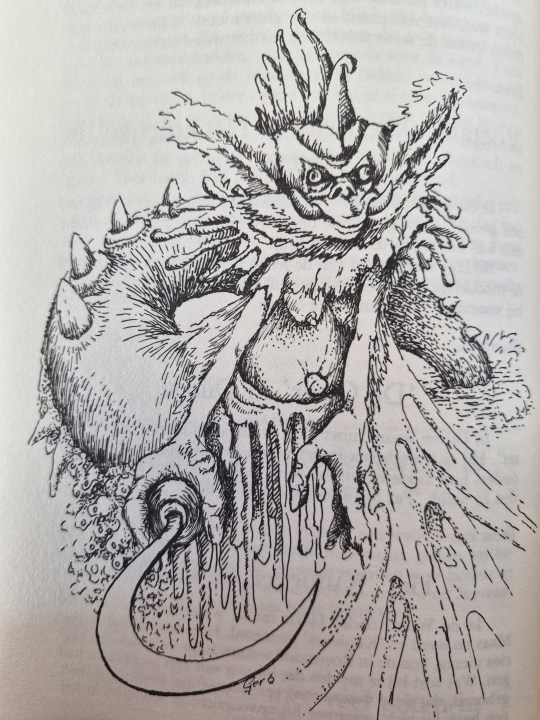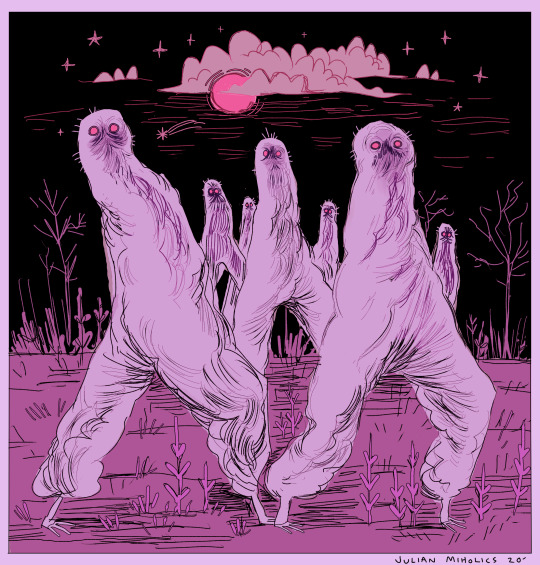Text
The Waterduivels [Belgian/Dutch folklore]:

Quite possibly the most common trope in global folklore is that of an aquatic monster that pulls people to a watery death. Perhaps this is because people from all cultures share a universal fear of drowning. In addition, parents from all over the world would tell children stories of aquatic bogeyman that lurked in ponds and rivers, to dissuade their offspring from playing near deep water.
In the Netherlands and Flanders, this folkloric niche is filled by the Waterduivel: a kind of hideous, aquatic fiend with a humanoid body, pitch-black skin and shining green eyes that burn like coals. As the name implies, they are demons that reside in rivers and other bodies of water, including wells. In the river Maas, waterduivels have been living since time immemorial. Their heads are adorned with a pair of horns and curved tusks, and they always carry their signature metal hooks which they use to drag their victims under the water. Sometimes these are staves with a hook on one end. They have a tail, presumably to help them swim, and sometimes their heads are said to be adorned with seaweed. Curiously, there is at least one account of these demons being feathered. At low tide, people would see their footprints in the soil.
Like many bogeymen characters, the waterduivels are mainly active at night and dusk, and during the day they hide in the riverbed. On Saint John’s Day in particular, which is July 24, these monsters are more dangerous than usual. They then climb out of the water and drag as many people as they can find below the waves. These creatures are said to drink human blood. Though the demons usually target children, they have also been known to drown adults. Swimmers in particular would sometimes be pulled down by the duivels.
Interestingly, these monsters are said to breed on the seafloor and then swim upstream through rivers when they are older.
The name ‘Waterduivel’ literally translates to ‘water devil’ or ‘aquatic devil’. In the Netherlands, the monster was also called a ‘Haokmenke’, which is an old Dutch word meaning ‘little man with a hook’, after their distinctive weapon. Note that the diminutive form likely denotes regional familiarity rather than actual physical size (except in Stokkem, where the creature is said to be a very short monster with many legs), so you can translate it more freely as ‘hookbearer’. The word ‘waterduivel’ is also sometimes used as a generic term for aquatic supernatural monsters.
In streams where these fiends were known to live, the locals sometimes heard strange noises coming from the water. The next morning, lots of dead fish could be seen floating on the surface. Nobody dared to eat them, for they knew the fish were killed by supernatural forces.

Because of their demonic nature, the waterduivels are weak to crucifixes: an old folktale from Snellegem tells of a priest who managed to trap one of these fiends underneath a tub. He placed a crucifix on top of it so that the creature could not escape. They also consort with witches, who disguise themselves as a horde of cats with bright white fur: in one story the protagonist is attacked by a waterduivel and later finds himself pursued by a herd of over 60 white cats. When he eventually gathered his courage, he attacked one of the pursuers and chopped off its front paw. When one of the women in the village was missing her hand the next morning, the people knew that she was a witch.
Supposedly, the city of Bruges was plagued by a waterduivel. One specific story tells how the creature met a very pretty girl whose boyfriend was a travelling minstrel and therefore spent most of his time away from home. The girl’s beauty attracted the attention of the demon, and he used his magic (for at least some of these creatures are adept at spellcasting) to disguise himself as a golden bird. In the form of the bird, he landed on her windowsill and promised her that if she came down to the water’s edge at exactly midnight, her lover would be there, waiting for her. She believed the talking bird, but instead of the handsome minstrel she was expecting, she found a horrible death as the monster sucked her blood and life force out of her body.
But not all of these stories had sad endings, for not all of the waterduivels were cunning and smart. There is a story about a waterduivel who resided in the Schaartje stream in Flanders: the creature was known for making horrible noises to frighten people away. Until one day, a very brave and very drunk man was walking to Sint-Jan and happened to pass by the stream. He heard the ruckus but wasn’t bothered in the slightest. Surprised at the lack of reaction, the monster climbed on land and the man asked him who he was. “I’m the waterduivel”, it said. “If you’re a waterduivel, then you should be able to swim” the drunkard replied. Though drunk, he was a physically strong and fit man, and so he had no trouble overpowering the fiend and throwing it into the water. It drowned there, for indeed the creature was incompetent and had never learned how to swim.
There is also a comedic tale about a waterduivel who scared a lone traveller at night by suddenly climbing on his back, and then he demanded to be carried.
Sources:
Janissen, L., 1981, Het Lokkend Licht, Volksverhalen rond de Maas in beide Limburgen, Van Kanne tot Kessenich en van Eijsden tot Mook, De Lijster Uitgeverij, 176 pp., p. 29-36.
De Cock, A., 1921, Vlaamsche Sagen uit den Volksmond, Maatschappij voor goede en goedkope lectuur, Amsterdam, 219 pp, p. 101.
Peeters, K. C., 1979, Vlaams Sagenboek, Davidsfonds, Leuven, p. 19-20.
Van Acker, R., 2020, Wandeling 7: Brugse Legenden, Uitgaven West-Vlaamse Gidsenkring, 88 pp. (tiny disclaimer: I did not read this source myself, I found the information via Marc Willems from Brugse Legenden).
Van Effeltere, K., Vlaamse Volksverhalenbank, ID 940, 942 and 943, Leuven University, online source.
(Image source 1: @another_maker on Instagram)
(Image source 2: Ger Janssen, illustration for Het Lokkend Licht)
#Belgian mythology#Dutch mythology#Demons#Aquatic creatures#Monsters#Creatures#Mythical creatures#Mythology#Folklore
24 notes
·
View notes
Text

Dragon
#cryptids#creatures#dragon#blue dragon#celestial dragon#winter dragon#snow dragon#mythical creatures
2 notes
·
View notes
Text

Headless Horseman (see Dullahan)
6 notes
·
View notes
Photo

fresno nightcrawler flock
16K notes
·
View notes
Text

Stolas
5 notes
·
View notes
Text

Vodenjak
#vodenjak#creatures#cryptids#slavic#slavic myth#slavic mythology#slavic folklore#mythical creatures#mythological creature
2 notes
·
View notes
Text

Mora
2 notes
·
View notes
Text

Grindylow
#grindylow#creatures#cryptids#harry potter lore#they look lovecraftian though#perhaps she was inspired by him
1 note
·
View note
Text

La Bête du Gévaudan
#la bête du gévaudan#creatures#cryptids#beast of gevaudan#wolf#french myth#french lore#mythical creatures#teen wolf
15 notes
·
View notes
Text

Bukavac
2 notes
·
View notes
Text

Dobhar-chú
#dobhar-chú#creatures#cryptids#mythical creatures#irish lore#irish folklore#celtic#celtic myth#celtic mythology
4 notes
·
View notes
Text

Kikimora
#kikimora#creatures#cryptids#mythical creatures#mythological creature#slavic#slavic folklore#swamp kikimora#married to leshy#house kikimora married to domovoi
24 notes
·
View notes
Text

Cú-Sídhe
#cú-sídhe#cù-sìth#cŵn annwn#black dog#hound#creatures#cryptids#irish#irish folklore#irish lore#scottish#welsh#mythical creatures#omen#mythical hound
5 notes
·
View notes
Text

Werehyena
4 notes
·
View notes
Text

Djerman
4 notes
·
View notes
Text

Drekavac
1 note
·
View note
